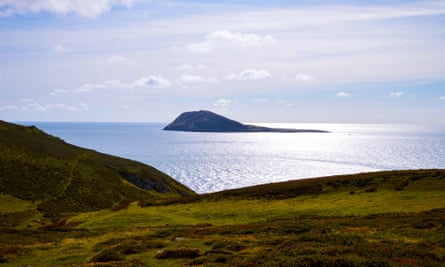The sunsets are wonderful but the night that follows even more spectacular. If it is clear, the moon and stars illuminate the tiny island vividly; when it is cloudy, the darkness is thick and unbroken, “bible black” to quote Dylan Thomas.
Ynys Enlli (Bardsey Island), two miles off the mainland of north-west Wales, has become the first site in Europe to receive international dark sky sanctuary certification, joining just 16 other spots in some of the most remote places in the world.
The island (permanent human population two in the winter, about a dozen in the summer) is off-grid and there are hardly any lights outside, with most of the buildings unchanged since they were built in the 19th century.
A small mountain shields most of the island from the tiny bit of light that may spill from the mainland, and the closest major light pollution comes from Dublin, more than 70 miles away across the Irish Sea.
The lighthouse has been switched from a sweeping white beam to a flashing red light designed not to impinge on the night. It means that when the sun goes down the island is, as the Welsh expression has it, “Yn dywyll fel bola buwch” – “as dark as a cow’s belly”.
Mari Huws, who works as a warden on the island with her partner, Emyr Owen, said it was a privilege to live there all year round.

“In a world that’s increasingly being polluted in every single way, having a pristine night sky at our doorstep still takes my breath away. It means that the night is alive – oyster catchers cry, Manx shearwaters swoop and owls glide, so much of the natural world is awake at night.”
The darkness is particularly good news for the shearwaters, which split their time between Ynys Enlli and South America. “During their breeding season, there is a colony of over 20,000 pairs of Manx shearwaters on the island,” said Huws. “Manx shearwaters are a nocturnal sea bird that are completely dependent on a dark sky to return unharmed to their burrows.
“The island is also home to nesting storm petrels, wood mice and a wide variety of moths. So much of nature has evolved to need a dark night sky at night. And there are no disadvantages for us to be living somewhere so dark – you just need to use a torch.”
Sian Stacey, the chair of the Bardsey Island Trust, said it had taken several years of hard work to achieve the certification, which is awarded by the Arizona-based International Dark-Sky Association (IDA).
“There’s no doubt that achieving this prestigious status for Ynys Enlli will raise the profile of the island as a unique place in Wales and amongst the best in the world to appreciate the night sky,” she said. “We hope it will also go a long way in securing the long-term sustainability of the island.”

Known as the island of 20,000 saints, owing to the Celtic and Christian monasteries established there since the 6th century, the population of Ynys Enlli, which is 1.5 miles long and no more than half a mile across, has fluctuated over the centuries.
Evidence suggests it was inhabited from as early as the bronze age. In the summer it is home to a small community of residents who work the land and fish, and there are also 10 cottages for visitors.
Ruskin Hartley, the executive director of the IDA, praised Ynys Enlli and Wales as a whole, which is working hard to keep its night skies dark.
Wales already has three “international dark sky places” – the Eryri (Snowdonia) and Brecon Beacons national parks in the north and south and the Elan Valley Estate in mid-Wales.
“Wales is fast becoming one of the leading nations in protecting dark skies as a precious resource that benefits people and wildlife,” said Hartley.
International dark sky sanctuaries
Sanctuaries are defined as the most remote (and often darkest) places in the world whose conservation state is most fragile.
!Ae!Hai Kalahari heritage park (South Africa)
Aotea/Great Barrier Island (New Zealand)
Niue (South Pacific)
Pitcairn Islands (southern Pacific Ocean)
Gabriela Mistral (Chile)
Stewart Island/Rakiura (New Zealand)
The Jump-Up (Australia)
Rainbow Bridge national monument (Utah, US)
Black Gap wildlife management area (Texas, US)
Boundary Waters Canoe area wilderness (Minnesota, US)
Cosmic Campground (New Mexico, US)
Devils River State natural area, Del Norte Unit (Texas, US)
Katahdin woods and waters national monument (Maine, US)
Lost Trail national wildlife refuge (Montana, US)
Massacre Rim wilderness study area (Nevada, US)
Medicine Rocks state park (Montana, US)